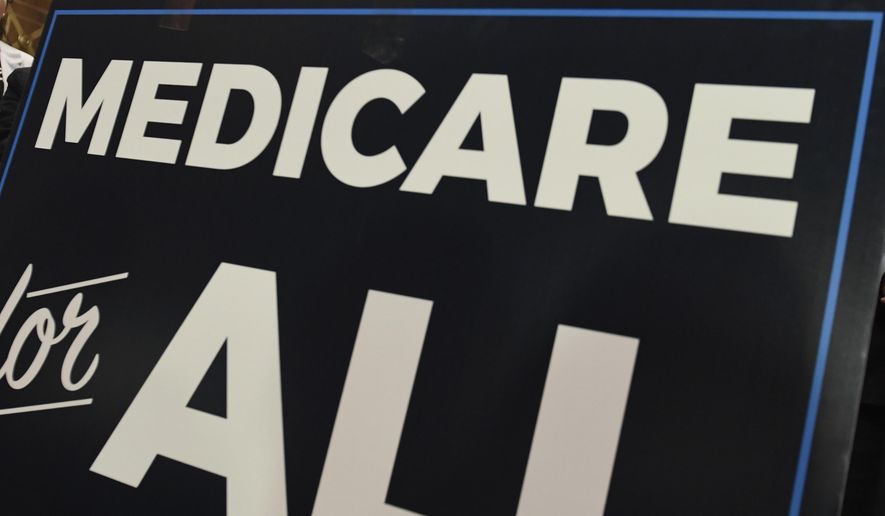Democrats’ aspirations for “Medicare for All” are smashing into the harsh realities of filling in the details of who gets covered and how much it will cost taxpayers, with budget analysts Wednesday warning the transformation “could be complicated, challenging, and potentially disruptive.”
The Congressional Budget Office said most of the 30 million people who remain uninsured in the U.S. would gain coverage under a government-run, single-payer system, though the percentage depends on whether immigrants who are living in the U.S. illegally are made eligible.
Free or low-cost insurance would prod patients to use more care, increasing federal spending.
Savings, meanwhile, could come from paying doctors less than the going commercial rate — an idea that comes with even more tradeoffs.
“The amount of care supplied and the quality of that care might diminish,” CBO Deputy Director Mark Hadley told the House Budget Committee.
Medicare for All is the marquee single-payer health plan sponsored by Sen. Bernard Sanders and backed by a number of the Democrats’ 2020 presidential hopefuls. But figuring out what it means in practice is proving tricky — particularly the price tag.
“We don’t have an estimate yet, in part because it would depend on so many of the design choices that people make, in terms of who’s covered and what kinds of services they receive,” Mr. Hadley told the House Budget Committee.
A single-payer system might decrease administrative costs and the “uncompensated care” payments that taxpayers shell out for uninsured persons who show up at hospitals, he said.
On the down side, he added, if the supply of doctors and services isn’t sufficient to handle the influx of newly insured Americans, then patients may face wait times and reduced access to care.
House Democratic leaders haven’t fully embraced Medicare for All, saying it’s best to focus on shoring up Obamacare.
Yet House Speaker Nancy Pelosi is testing the single-payer waters, allowing the House Rules and Budget committees to explore how heavy a lift a nationwide insurance program would be.
Rep. John Yarmuth, chairman of the Budget Committee, said if they pursue the idea, reforms must be done “carefully and methodically,” but “not without urgency.”
“Access to affordable health care isn’t just a policy proposal or a political slogan — it’s life or death for millions of Americans,” the Kentucky Democrat said.
Committee Republicans loathe the idea of a European-style health care system, pointing to independent analyses that say the program would cost more than $30 trillion over a 10-year budget window.
Republicans also bemoaned the lack of an official CBO estimate.
“My friends across the aisle didn’t ask for one — I think I know why,” said Rep. Steve Womack, Arkansas Republican.
The administration has also been vocal about its opposition to Medicare for All, saying it will harm the existing federal program for seniors.
“When I see policies that I think harm the program and harm its beneficiaries, then I think it’s my duty to speak out about that and inform the public about that,” Seema Verma, administrator of the Centers for Medicare and Medicaid Services, told reporters.
For his part, President Trump is using the Medicare for All mantra to attack his political rivals heading into the campaign, saying they are embracing socialism.
Mr. Hadley told Congress the CBO doesn’t have its own definition of “socialism,” but he described the shifts that would result from a single-payer system.
Households and businesses contribute just under half of the $3.5 trillion in total health spending today, and a single-payer system would shift a good share of that onto federal or state governments, Mr. Hadley said.
Republicans say that will mean higher taxes and few, if any, choices.
Those drawbacks have made some Democrats hesitant to completely redo the health system.
Rep. Seth Moulton, Massachusetts Democrat who is running for president, said a public option that competes with private plans is a wiser option, saying his experience with the Department of Veterans Affairs makes him hesitant to embrace a socialized system that nudges aside private alternatives.
He said he’s seen positive work at the VA but also “the bad and the ugly” — such as receiving the wrong medication or watching as they struggle to locate his records.
• Tom Howell Jr. can be reached at thowell@washingtontimes.com.




Please read our comment policy before commenting.